15–20 minute read
Routine Care
fertilizing
- Feed azaleas, camellias and gardenias if needed. Yellow leaves with green veins indicate iron deficiency. Apply iron chelate or treat the surrounding soil with aluminum sulfate.
- Feed nandinas with a complete fertilizer.
- Fertilize climbing roses after they bloom.
mulching
To conserve moisture and suppress weeds, mulch established plants to a depth of 2 to 3 inches. New plantings should be mulched only to a depth of about 1 inch. Deeper mulch can cause drought stress. Keep mulch away from plant crowns because trapped moisture can promote rot and disease.
Find the best mulch for your situation
How to apply mulch
tidying
- Trim dried-up foliage of spring flowering bulbs.
- Thin out annuals such as marigolds and zinnias.
- Stake hollyhocks, tall lilies and other tall flowering plants.
watering
Most plants need 1–1.25 inches of water per week. Because hard downpours can run off without soaking in, plants can need water even after a 3-inch rainfall.
In a drought, use longevity as a guide: water trees first, then shrubs, then perennials.
Special tasks
planting & Propagating
- It is not too late to plant summer annuals like begonia, geranium, marigold, petunia, and zinnia.
- Late June is the ideal time to take semi-hardwood cuttings of azaleas, camellia, cotoneaster, holly, pieris, and rhododendron.
- Divide spring-flowering bulbs such as tulips, Dutch iris and narcissus as soon as foliage dies down. Replant immediately. You need not divide each year, but do so often enough to keep bulbs from becoming root-bound.
pruning
| Jan | Feb | Mar | Apr | May | Jun | Jul | Aug | ||||||||||
|---|---|---|---|---|---|---|---|---|---|---|---|---|---|---|---|---|---|
| TREES | |||||||||||||||||
| shade | |||||||||||||||||
| bleeder | small branches | ||||||||||||||||
| fruit | |||||||||||||||||
| SHRUBS | |||||||||||||||||
| summer-blooming | after bloom | ||||||||||||||||
| spring-blooming | after bloom | ||||||||||||||||
| broadleaf EG | dieback | ||||||||||||||||
| needle EG | |||||||||||||||||
| HERBACEOUS | |||||||||||||||||
| grasses | |||||||||||||||||
| flowers | pinch, deadhead | ||||||||||||||||
- Pinch back mums through early July.
- Cut off the faded flowers of annuals, phlox, shasta daisy and daylily to encourage a second flowering (perennials) or continual bloom (annuals).
- Prune needle evergreens. Prune out dieback on broadleaf evergreens. Monitor gardenias and delay pruning until you are certain that a branch is dead — when gardenias lose their leaves from cold injury, they often are just beginning to put out new growth now.
- Prune summer-blooming shrubs like abelia, althea, deutzia, euonymus, forsythia (a spring bloomer), bush honeysuckles, macrophylla hydrangeas, mock orange, privets, and weigela. These bloom on year-old wood. Prune as soon as they have finished blooming (or for hydrangeas, once the flowers fade) so that you do not remove the flower buds for next year. Hydrangeas that bloom on new wood as well as old can be pruned like older varieties.
- Prune climbing roses after they bloom. Train long shoots horizontally or downward to stimulate more branching and more profuse bloom — most climbing roses exhibit apical dominance, where the terminal bud on a branch suppresses bud formation along the rest of the branch as long as it is located at the highest point.
- When cutting roses for the house or removing spent blooms, choose a 5-leaf leaflet that points away from the center of the bush. Cut at a 45-degree angle so the selected leaflet is ¼” below the upper end of the slope. The American Rose Society recommends selecting a leaflet near the top of the cane for the first round of deadheading and farther down for subsequent trimmings. The lower you cut on the cane the thicker the new growth will be and the larger the new flowers, but you will remove more of the foliage that fuels plant growth. Cuts higher on the cane result in more, but smaller flowers.
- Late June is the recommended time to prune white pine. Trim new growth only.
- Remove water sprouts on any fruit trees and crabapples.
- Remove any dead wood or weak branches on crape myrtles so new growth will be vigorous and show good form.
soil Test
It is a good idea to test your soil every 2–3 years so that you can adjust pH and fertilize more accurately. Testing is free from April–November. You can pick up and drop off soil boxes, forms, and sampling instructions 8am–5pm M–F in the lobby of the Extension Office: Bonnie B Davis Center, 1020 US-70W.
Learn more about soil testing
problems
disease
Be proactive about fungal disease. The best approach is to purchase genetically resistant cultivars. Otherwise, think of fungicides as vaccines that prevent diseases rather than curing them. Apply fungicide when conditions favor disease development but before symptoms appear.
Minimize dogwood diseases. Keep them watered, maintain soil fertility and clean up leaf litter to reduce disease pressure. When purchasing a flowering dogwood (Cornus florida), seek out disease-resistant cultivars like ‘Cherokee Brave’ (pink bloom, partial resistance), ‘Jean’s Appalachian Snow’ (white bloom, high resistance), or ‘Kay’s Appalachian Mist’ (white bloom, high resistance). Alternatively, plant a Kousa dogwood (complete resistance) or a florida-kousa hybrid from the Rutgers ‘Constellation’ series (moderate resistance).
pests
Beneficial insects share the same plants as insect pests. To protect beneficials, use low-toxicity pesticides when possible, spray only if needed and spray at dusk when pollinators are no longer active. Always read and follow label directions for safe pesticide application.
Click on a pest name in the pest calendar below to learn more.
| Jan | Feb | Mar | Apr | May | Jun | Jul | Aug | Sep | Oct | Nov | Dec |
|---|---|---|---|---|---|---|---|---|---|---|---|
| Emerald ash borer | |||||||||||
| tent caterpillar | |||||||||||
| black vine weevil | |||||||||||
| spider mites | |||||||||||
| scales, slugs | |||||||||||
| aphids, lace bugs | |||||||||||
| bagworm | pick bags | ||||||||||
| boxwood leaf miner | |||||||||||
| ironweed longhorn borer | |||||||||||
| flatid planthopper Japanese beetle CATERPILLARS: genista broom moth silvery checkerspot fall webworm | |||||||||||
| twospotted spider mite kudzu bug | |||||||||||
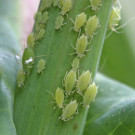 Aphids are usually green but can be many other colors. They attack tender new plant growth. Fortunately, they can be washed off with a forceful stream of water. Severe infestations can be controlled with the relatively environmentally benign insecticidal soaps.
Aphids are usually green but can be many other colors. They attack tender new plant growth. Fortunately, they can be washed off with a forceful stream of water. Severe infestations can be controlled with the relatively environmentally benign insecticidal soaps.
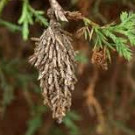 Bagworms can be controlled by hand-removing the bags before adults emerge in August–September (sprays cannot penetrated the bags) and during the fall, winter and spring, before the eggs hatch in May. Use a sharp knife/utility razor to cut the silk wrapped around the twig to prevent later girdling. Conifers like Conifers like arborvitae, cedar, juniper and pine sustain the most damage, but caterpillars also feed on many deciduous species such as willow, maple, locust, sycamore and elm. Scout buildings as well because often the bags are attached to siding.
Bagworms can be controlled by hand-removing the bags before adults emerge in August–September (sprays cannot penetrated the bags) and during the fall, winter and spring, before the eggs hatch in May. Use a sharp knife/utility razor to cut the silk wrapped around the twig to prevent later girdling. Conifers like Conifers like arborvitae, cedar, juniper and pine sustain the most damage, but caterpillars also feed on many deciduous species such as willow, maple, locust, sycamore and elm. Scout buildings as well because often the bags are attached to siding.
 Japanese beetles vary in number from year to year. Control by any method is difficult to achieve unless it covers a significant area. This requires careful monitoring and the coordinated effort of an entire neighborhood. A recommended alternative is to keep plants healthy (weak plants are more susceptible), to remove beetle attractants such as prematurely ripened or diseased fruit and to plant resistant species. The link gives details on beetle lifecycle, monitoring, control, and species susceptibility.
Japanese beetles vary in number from year to year. Control by any method is difficult to achieve unless it covers a significant area. This requires careful monitoring and the coordinated effort of an entire neighborhood. A recommended alternative is to keep plants healthy (weak plants are more susceptible), to remove beetle attractants such as prematurely ripened or diseased fruit and to plant resistant species. The link gives details on beetle lifecycle, monitoring, control, and species susceptibility.
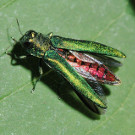 Emerald ash borers have been confirmed in Orange County. They attack all species of native ash as well as our native white fringetree. The top of the crown begins to thin and partially die (sprouting from the main stem of the tree may also occur), followed by death within 2–5 years. While the borers spread a few miles per year by flight, the main route of spread is from contaminated firewood. Interstate movement of EAB-host wood and wood products is prohibited for all of NC. However, movement within our state is not. Please be cautious when purchasing or accepting firewood, wood chips, etc. if you suspect that your trees are infected, please report the location and descriptions of potentially infested trees to 800-206-9333 or newpest@ncagr.gov.
Emerald ash borers have been confirmed in Orange County. They attack all species of native ash as well as our native white fringetree. The top of the crown begins to thin and partially die (sprouting from the main stem of the tree may also occur), followed by death within 2–5 years. While the borers spread a few miles per year by flight, the main route of spread is from contaminated firewood. Interstate movement of EAB-host wood and wood products is prohibited for all of NC. However, movement within our state is not. Please be cautious when purchasing or accepting firewood, wood chips, etc. if you suspect that your trees are infected, please report the location and descriptions of potentially infested trees to 800-206-9333 or newpest@ncagr.gov.
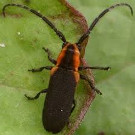 Ironweed longhorn borers attack many species in addition to ironweed, including coneflowers (purple coneflowers, sunflowers, heliopsis, etc.), bloodwort, verbesina, turtleheads, fall-blooming anemones, and even shrubs like beautyberries. The beetle creates a series of wounds in which eggs are laid, then girdles the stem below the egg holes. Cut off the wilted stem below the lowest wound and dispose — don’t compost — so that larvae cannot mature.
Ironweed longhorn borers attack many species in addition to ironweed, including coneflowers (purple coneflowers, sunflowers, heliopsis, etc.), bloodwort, verbesina, turtleheads, fall-blooming anemones, and even shrubs like beautyberries. The beetle creates a series of wounds in which eggs are laid, then girdles the stem below the egg holes. Cut off the wilted stem below the lowest wound and dispose — don’t compost — so that larvae cannot mature.
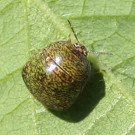 Kudzu bugs are a new pest from India and China that look somewhat like an olive lady beetle. They feed on all types of legumes (note that wisteria is a legume) and congregate on figs, magnolias, bronze fennel, redbuds, roses and peppers. Because they are so new, control strategies are still experimental. Carefully brushing them into soapy water is one approach (they release an irritant when crushed). Some predatory insects like assassin bugs and predatory stink bugs appear to be finding them, which may help to control population size.
Kudzu bugs are a new pest from India and China that look somewhat like an olive lady beetle. They feed on all types of legumes (note that wisteria is a legume) and congregate on figs, magnolias, bronze fennel, redbuds, roses and peppers. Because they are so new, control strategies are still experimental. Carefully brushing them into soapy water is one approach (they release an irritant when crushed). Some predatory insects like assassin bugs and predatory stink bugs appear to be finding them, which may help to control population size.
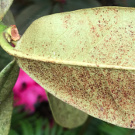 Lace bugs can attack new growth, usually only on azalea/rhododendron, but sometimes on pyracantha, cotoneaster, quince or hawthorne. Dark spots about the size of a pinhead on the lower leaf surface are diagnostic. The best defense is to plant genetically resistant varieties and to maintain plant vigor. For control of severe infestations where there is no evidence that natural predators are present, repeated applications of insecticidal soap or horticultural oil can be effective. When a history of lace bug infestation exists, insecticides can be applied to the lower leaf surface, usually two applications approximately two weeks apart. Monitor the plants about once a month for reinfestations.
Lace bugs can attack new growth, usually only on azalea/rhododendron, but sometimes on pyracantha, cotoneaster, quince or hawthorne. Dark spots about the size of a pinhead on the lower leaf surface are diagnostic. The best defense is to plant genetically resistant varieties and to maintain plant vigor. For control of severe infestations where there is no evidence that natural predators are present, repeated applications of insecticidal soap or horticultural oil can be effective. When a history of lace bug infestation exists, insecticides can be applied to the lower leaf surface, usually two applications approximately two weeks apart. Monitor the plants about once a month for reinfestations.
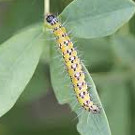 Genista broom moth caterpillars can rapidly defoliate a baptisia.
Genista broom moth caterpillars can rapidly defoliate a baptisia.
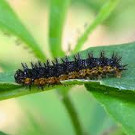 Silvery checkerspot caterpillars can defoliate coneflowers such as sunflowers, false sunflowers, purple coneflowers, and black-eyed susans. The checkerspot is a nice butterfly and the caterpillars usually do not require any control, but in some years they can be destructive. For control, caterpillar-specific approaches are Bt, Bacillus thuringiensis for small caterpillars (½ inch long or less) and spinosad for larger caterpillars. Bt has only a short residual activity, so multiple applicatons may be required. Feeding is required for these to work, so some damage will still occur.
Silvery checkerspot caterpillars can defoliate coneflowers such as sunflowers, false sunflowers, purple coneflowers, and black-eyed susans. The checkerspot is a nice butterfly and the caterpillars usually do not require any control, but in some years they can be destructive. For control, caterpillar-specific approaches are Bt, Bacillus thuringiensis for small caterpillars (½ inch long or less) and spinosad for larger caterpillars. Bt has only a short residual activity, so multiple applicatons may be required. Feeding is required for these to work, so some damage will still occur.
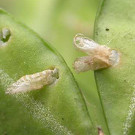 Boxwood leafminers feed inside the leaf, causing blisters on the underside. American boxwood varieties are more susceptible. Prune the foliage in May before adults emerge or right after adult flies lay their eggs. If insecticide is needed, apply when new leaves are fully formed (Weigela bloom is a good indicator of timing), then once more between mid-June and mid-July.
Boxwood leafminers feed inside the leaf, causing blisters on the underside. American boxwood varieties are more susceptible. Prune the foliage in May before adults emerge or right after adult flies lay their eggs. If insecticide is needed, apply when new leaves are fully formed (Weigela bloom is a good indicator of timing), then once more between mid-June and mid-July.
 Twospotted spider mites enjoy hot, dry weather and can attack many different species. They are difficult to see without a magnifying lens. Symptoms include bleaching, stippling and webbing on leaves. A strong spray of water on leaf undersides can offer some control. For more severe infestations, consider insecticidal soaps or horticultural oil spray.
Twospotted spider mites enjoy hot, dry weather and can attack many different species. They are difficult to see without a magnifying lens. Symptoms include bleaching, stippling and webbing on leaves. A strong spray of water on leaf undersides can offer some control. For more severe infestations, consider insecticidal soaps or horticultural oil spray.
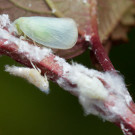 Flatid planthopper nymphs look like mealy bugs at first glance, but they usually do little damage and do not require treatment.
Flatid planthopper nymphs look like mealy bugs at first glance, but they usually do little damage and do not require treatment.
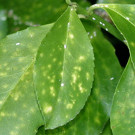 Scales are divided into two groups, armored and soft, based on their coverings. Armored scales usually have several generations a year, can kill woody plants and must be controlled when numerous. Soft scales have a single generation yearly, reduce plant vigor and can lead to unsightly sooty mold, but do not usually kill plants. Often, scale is controlled by beneficial predators. If necessary, try one of the following: 1) Prune out heavily infested shoots/branches 2) On deciduous species, apply horticultural oils or soaps, which will kill all scale stages. 3) Use a registered insecticide to kill crawlers. Monitor for crawlers (tiny, pale yellow specks) by using double-sided sticky tape on several branches.
Scales are divided into two groups, armored and soft, based on their coverings. Armored scales usually have several generations a year, can kill woody plants and must be controlled when numerous. Soft scales have a single generation yearly, reduce plant vigor and can lead to unsightly sooty mold, but do not usually kill plants. Often, scale is controlled by beneficial predators. If necessary, try one of the following: 1) Prune out heavily infested shoots/branches 2) On deciduous species, apply horticultural oils or soaps, which will kill all scale stages. 3) Use a registered insecticide to kill crawlers. Monitor for crawlers (tiny, pale yellow specks) by using double-sided sticky tape on several branches.
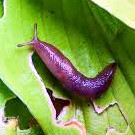 Slugs can attack soft new growth. Holes in leaves or on leaf margins and a silvery slime trail in the morning indicate slug damage. Because slugs hide under boards, stones or debris during the day, populations can be reduced by managing habitat and trapping. Alternative approaches are either ineffective (barriers like diatomaceous earth or copper) or toxic (metaldehyde baits are toxic to pets/children; iron phosphate baits containing EDTA have been found to be toxic to earthworms). To trap, try laying a board near the target plants. Lift at midday and remove the slugs clinging on the bottom.
Slugs can attack soft new growth. Holes in leaves or on leaf margins and a silvery slime trail in the morning indicate slug damage. Because slugs hide under boards, stones or debris during the day, populations can be reduced by managing habitat and trapping. Alternative approaches are either ineffective (barriers like diatomaceous earth or copper) or toxic (metaldehyde baits are toxic to pets/children; iron phosphate baits containing EDTA have been found to be toxic to earthworms). To trap, try laying a board near the target plants. Lift at midday and remove the slugs clinging on the bottom.
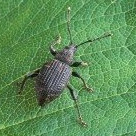 Black vine weevils are destructive to yew, hemlock, rhododendron and several other broad-leaved evergreens. To detect infestation, examine leaves for marginal notches. This cosmetic damage is the result of adults feeding at night and does not endanger the plant. However, the grubs can kill plants by feeding on roots and girdling the lower stems. Treatments targeting adults may be more effective than those for grubs in the landscape setting. See the link for details.
Black vine weevils are destructive to yew, hemlock, rhododendron and several other broad-leaved evergreens. To detect infestation, examine leaves for marginal notches. This cosmetic damage is the result of adults feeding at night and does not endanger the plant. However, the grubs can kill plants by feeding on roots and girdling the lower stems. Treatments targeting adults may be more effective than those for grubs in the landscape setting. See the link for details.
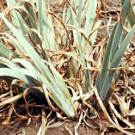 Iris problems depend on the iris type, with beardless types suited to our area being mostly trouble-free. Good sanitation in fall is sufficient for control of many problems. Monitor for healthy foliage and if you see a problem, view the link for a comprehensive list.
Iris problems depend on the iris type, with beardless types suited to our area being mostly trouble-free. Good sanitation in fall is sufficient for control of many problems. Monitor for healthy foliage and if you see a problem, view the link for a comprehensive list.
weeds
For common weeds not mentioned below, try this weed gallery. You can check for the toxicity, groundwater risk and persistance of many weed products in Toxicity of Lawn Chemicals.
- Treat perennial weeds such as wild onion and wild garlic with a broadleaf herbicide when temperatures are above 50°. Be careful to distinguish mock strawberry, an invasive alien, from our native barren strawberry.
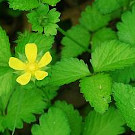 weed mock strawberry
weed mock strawberry wildflower barren strawberry
wildflower barren strawberry - Killing or removing weeds before they seed is critical for control. This is especially important for the two new 'superweeds' below. While both are annuals, they are extremely aggressive and produce copious seed, rapidly colonizing your yard if left unattended.
